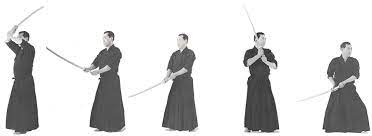Background
‘Previously’ ...
The name ken tai ichi no kata has been translated as, ‘form of sword and body as one.’
The description of this kata in Jan de Jong: The man, his school, and his ju jitsu system is: ‘Demonstration of katana and the unarmed applications’ (Jan de Jong Self Defence School, 1997, p. 50).
The kata as taught within the JDJ jujutsu shodan grading consists of five sword v. sword and five unarmed v. unarmed attack-defence sequences.
The grading sheet reads:
1. Yoko Tekubi Hishigi: Tori – Seigan Kamae, Uke – Seigan Kamae
2. Ude Kujiki: Tori – Seigan Kamae, Uke – Gedan Kamae
3. Tekubi Te Nage: Tori – Seigan Kamae – Gedan Kamae, Uke – Jodan Kamae
4. Ude Hiji Nage: Tori – Hasso Kamae, Uke – Hasso Kamae
5. Ura Tai Otoshi: Tori – Gedan Kamae, Uke – Gedan Kamae
The first phrase represents the unarmed technique that is being demonstrated. The tori and uke kamae description refer to the ‘combat engagement posture’ (see Donn Dreager) for the sword attack-defence sequence.
An example of the JDJ kata was posted on YouTube by the Hans de Jong Self Defence School (HDJSDS), a JDJ ryuha.
We saw in the post titled ‘Ken Tai Ichi no Kata Example’ that ken tai ichi no kata is a Yoseikan Budo (YB) kata. An example of the YB kata was posted on YouTube as part of a larger video taken from the Yoseikan Sogo Budo DVD set by Minoru Mochizuki, the founder of YB. The ken tai ichi no kata is located at the 22:40 mark in the aforementioned YouTube video.
The YB kata consists of five sword v. sword, five unarmed v. sword, and five unarmed v. unarmed attack-defence sequences. The subtitles on that video refer to these sequences as ken (sword) and tai (unarmed), thus: ken-ken, tai-ken, and tai-tai. Those are the terms that will be used in this post.
JDJ did not include the tai-ken sequence in his ken tai ichi no kata (see above). Interestingly, when looking for video examples to assist the readers of this post, I came across a YouTube video of Mochizuki demonstrating this kata in which he also does not include the tai-ken sequence. 'What's going on here?'
‘What’s going on here?’ is how cognitive psychologist Gary Klein operationalises the curiosity path to gaining insight that can lead to a new and better understanding. It is a new understanding because it did not exist before, and it is a better understanding because it is more accurate, more comprehensive, and more useful than the one that existed before.
The ‘What’s going on here?’ reaction does not contain the insight, but it can start the person on the road to gaining the insight if they go looking for an answer to their question. This can never happen if teachings are never questioned.
JDJ had a different attack-defence order to that of the kata demonstrated in the YB videos:
JDJ's #1 = YB's #2
JDJ's #2 = YB's #1
JDJ's #3 = YB's #5
JDJ's #4 = YB's #4
JDJ's #5 = YB's #3
This ordering is provided for those that want to visually compare like-with-like as I discuss the kata in JDJ's system and that of YB.
Core of All Learning
In Classroom Instruction That Works: Research Based Strategies for Increasing Student Achievement, Marzano, Pickering, and Pollock (2001) explain that the ‘core of all learning’ is the identification of similarities and differences. They go on to explain that the four proven highly effective ways of identifying similarities and differences are classification, comparison, creating metaphors, and creating analogies. I devote a chapter in my book on the science behind all fighting techniques to this subject providing examples within the martial arts of the use of these ways of identifying similarities and differences to teach techniques.
Identifying similarities and differences provides the opportunity for gaining insights that can lead to a new and better understanding (see above). It behoves all teachers and learners to understand and apply this concept. Teachers will be better teachers and learners will be better learners, in addition, learners will not be as reliant on their teachers being good teachers.
The core of all learning – the identification of similarities and differences – will be used here when studying the ken tai ichi no kata attack-defence sequences and which can provide insights that lead to a new and better understanding not only of the kata itself but of principles in general.
Comparing Tori Kamae
‘What is the difference between the kamae of tori in the first ken-ken defence and that of the other four?’ That is a question that I posed/pose to those learning this kata.
Answer: the tori kamae in the first ken-ken defence is seigan no kamae (see image below) which is totally defensive. The tip of the blade is pointed at uke’s throat or eyes and if uke attacks straight down the line they will be impaled on tori’s sword if tori does not move.
In the other four kamae of tori, they are not seigan no kamae and invite an attack. It is a genuine invitation as tori is providing a genuine opening, however, they are also setting up with an attacking kamae of their own. If uke is good enough, their attack may prove successful as the opening is a genuine opening.
This comparison (identification of similarities and differences) provides a strategic lesson which is not forthcoming for those that simply train what they are taught without question in order to pass a grading. Ditto for those that teach what they are taught without question because it is part of the curriculum. No, or very little, insight is achieved in those circumstances.
Tori Kamae #2
Another path to insight is contradictions. Klein explains that, ‘Contradictions are different from curiosity insights. Curiosities make us wonder what’s going on, whereas contradictions make us doubt— "That can’t be right."' (2013, p.61).
When researching this post and attending to the detail, I noticed that the JDJ grading sheet for the ken tai ichi no kata grading included seigan no kamae for both #1 and #2 ken-ken sequences. ‘That can’t be right.’ It isn’t.
I studied the Jan de Jong Self Defence School (JDJSDS) representative HDJSDS video (see above) and found that tori in that video did in fact assume seigan no kamae and uke attacked down the line thus risking being impaled on tori’s sword if tori did not execute a block/deflection or an evasive body-movement (see future post about the 'dog's breakfast' that is the blocking sections in the mon gradings). ‘That can’t be right.’ It isn’t.
I studied the YB video and found that tori assumed seigan no kamae before lowering to gedan no kamae to invite at overhead attack. That is how it was taught in the JDJSDS, although that is not how it is described on the grading sheet.
While misremembering an attack can be forgiven (also see JDJ misremembering the attack for the final ken-ken sequence). While not providing an accurate description on the grading sheet can be forgiven. While being misled by an incomplete instruction on the grading sheet can be forgiven. What cannot be forgiven is the teaching and/or performing techniques, defence and/or attack, that are clearly flawed. It shows an astonishing lack of understanding ... or indifference.
Insight Applied
The insight gained from the above analysis applies to the te nage defence from ryo te dori in the shinken shobu no kata grading in shodan (JDJ misinterpreted/did not understand the aikido/YB technique). It applies to the irimi uke, te gatame ude kujuki defence from jodan tsuki in the 5th kyu grading (see previous). It applies to the oshi otoshi technique in the taoshi waza no kata grading in sandan (JDJ did not understand the YB technique taken from a single hand-drawn image from Mochizuki's book; see future post re sandan grading). It applies to the belt drop, back fist defence from rear body-hold over elbows in the HDJSDS shinken shobu no kata grading in their shodan (misremembered the attack taught in the JDJ grading).
Next Post
These posts are long; longer than intended. I will be trying to break them up into more 'bitesize' portions. The next post(s) will commence analysing each of the individual attack-defence and which will include a comparison with those taught by YB from whence they were appropriated.
PS: It would appear that this is part of my JDJ martial arts legacy. I doubt that I'll ever teach again, so, I am sharing some of my unique insights and understanding through these posts.




Thank you sensei John. I train aikido under sensei Paul at Jan de Jong Martial Arts Fitness. These posts are really interesting. They are giving me more to think about when learning this kata for my grading. It means that it is teaching me more than just to do it for a grading. I'm looking forward to the next post.
ReplyDeleteThese are just a few random thoughts that sprang to my mind when reading this blog post.
ReplyDeleteI was graded (aikido) on ten of the five techniques in this kata. Others, within the JdJ sphere and / or within the Yoseikan sphere did also. (I know that is not the most diplomatic wording but, if anyone finds offence in it, I ask them to see it as a feeble attempt at humour).
For all of the techniques in the first set the same draw was used, which took both players into seigan no kamae.
When performing the kata, the initial distance was much greater between the ‘players’ and the attack was launched on the third step toward one another. (We had a large dojo). This completely changes the dynamics of the performance and eliminates the problem that arises when facing seigan no kamae from one step for the side wrist lock / wrist crush. (Yoseikan outside of JdJ classified the two as one).
For each of the other techniques in the first set, one or other of the players shifted from seigan no kamae into another stance
When demonstrating the 6th-10th techniques as a set, a formal opening and closing was performed. At some time the ceremony seems to have been separated from the kata: I do not know whether it survived all of the revisions.
For 8 of the 10 techniques the same draw was used.
There is substantial evidence, including video evidence, of variations in the performance of aspects of katas.
My childhood hero, the science communicator Prof Julius Sumner Miller liked to ask “why is it so.” I do not remember whether or not he ever used maybes or sometimes. I hope that he did.
When discussing the above post with another person I "automatically" referred to maai as protecting uke from impalement. This is a much better thought than the extra steps.
ReplyDelete